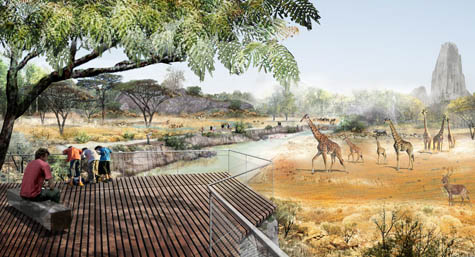 [Image: The future Zoo de Vincennes by TN PLUS Landscape Architects, with additional architecture by Beckmann N'Thepe].
[Image: The future Zoo de Vincennes by TN PLUS Landscape Architects, with additional architecture by Beckmann N'Thepe].A few months ago we took a look at plans for a new zoo in Vincennes, France, being developed by landscape architects TN PLUS. I've since been in touch with the firm, who have sent in more images of the proposed landscape. I thought I'd post them here, then, even as I also refer everyone back to the earlier post.
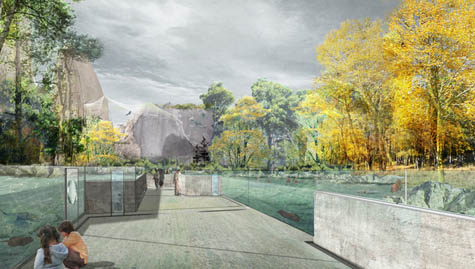 [Image: The Zoo de Vincennes by TN PLUS Landscape Architects].
[Image: The Zoo de Vincennes by TN PLUS Landscape Architects].I have to register my fascination again, however, with the idea that zoos actually represent a kind of spatial hieroglyphics through which humans communicate – or, more accurately, miscommunicate – with other species.
That is, zoos are decoy environments that refer to absent landscapes elsewhere. If this act of reference is read, or interpreted correctly, by the non-human species for whom the landscape has been constructed, then you have a successful zoo. One could perhaps even argue here that there is a grammar – even a deep structure – to the landscape architecture of zoos.
Zoos, in this way of thinking, are at least partially subject to a rhetorical analysis: do they express what they are intended to communicate – and how has this meaning been produced?
Landscape architecture becomes an act not just of stylized geography, or aesthetically shaped terrain, but of communication across species lines.
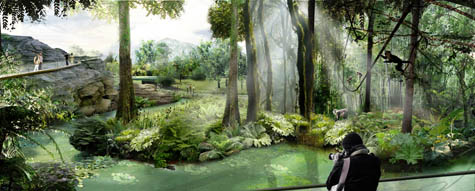
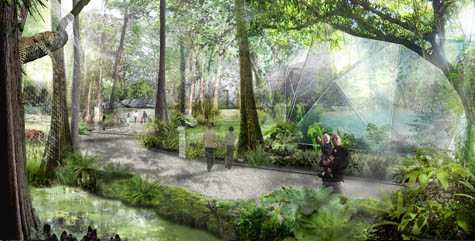 [Images: The Zoo de Vincennes by TN PLUS Landscape Architects].
[Images: The Zoo de Vincennes by TN PLUS Landscape Architects].Of course, this can also be inverted: are these landscapes really meant to be read, understood, and interpreted by what we broadly refer to as "animals," or are these landscapes simply projections of our own inner fantasies of the wild? Or should I say The Wild?
While this latter scenario sounds much more likely to be the case – humans, like a broken cinema, always live inside their own projections – nonetheless, the non-human communicational possibilities of landscape architecture will continue to fascinate me.
 [Image: The Zoo de Vincennes by TN PLUS Landscape Architects].
[Image: The Zoo de Vincennes by TN PLUS Landscape Architects].In fact, briefly, I'm reminded of two things:
- 1) Fritz Haeg's Animal Estates initiative, in which small homes for animals are constructed to house the native, pre-human population of urban landscapes around the world. Haeg explains that he "creates dwellings for animals," and that these "prototype Animal Estates will be established in a variety of environments. (...) Each will be designed to attract and welcome a particular animal back into an environment that has been dominated by humans. The design for each estate will be developed with a local specialist on that particular animal."
2) Temple Grandin, who could perhaps be described as an autistic animal theorist. Grandin has been campaigning for the re-design of slaughterhouse environments in order that they be less terrifying for animals; but what's particularly interesting about her campaign is that – if I've understood this correctly – she has extrapolated from her own subjective experiences of autism in order to model how animals might experience slaughterhouse architecture. Human autism here becomes strangely elided with animal subjectivity. Grandin has thus developed an entire phenomenological architecture that takes advantage of natural animal behaviors – circling, herding, grouping, and so on – by spatializing these behaviors into the built environment. Animal movements trace out spatial parameters that the architecture itself later takes. The animals are thus doing what they would have been doing "naturally" as they enter the spinning blades...
To put even more of an academic spin on this, zoos are speech acts.
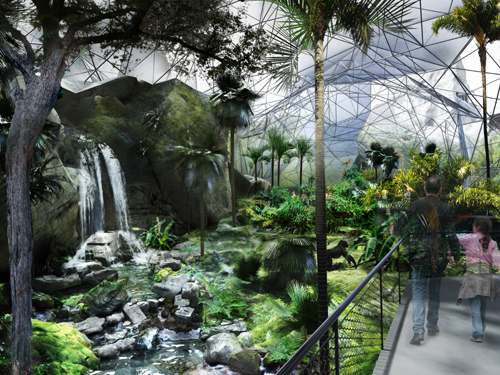 [Image: The Zoo de Vincennes by TN PLUS Landscape Architects].
[Image: The Zoo de Vincennes by TN PLUS Landscape Architects].But I've said much the same before; check out the earlier post for more.
No comments:
Post a Comment